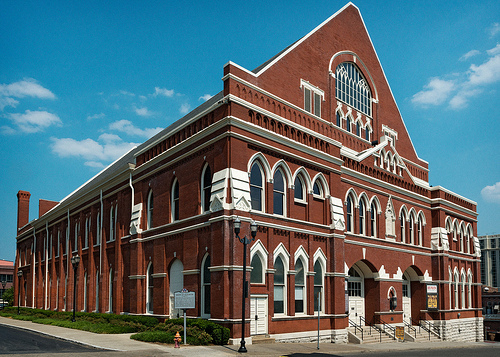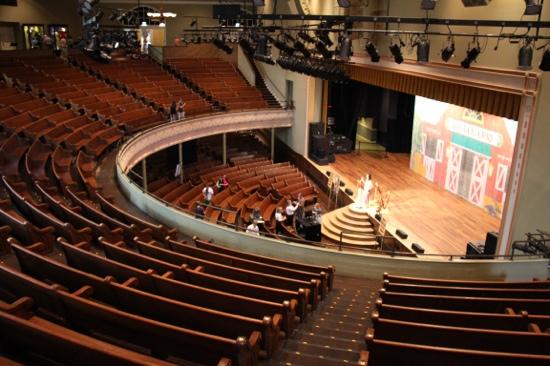Ryman Auditorium
 Ryman Auditorium (formerly Grand Ole Opry House and Union Gospel Tabernacle) is a 2,362-seat live performance venue, located at 116 5th Avenue North, in Nashville, Tennessee and is best known as the most famous former home of the Grand Ole Opry. It is owned and operated by Ryman Hospitality Properties, Inc.
Ryman Auditorium (formerly Grand Ole Opry House and Union Gospel Tabernacle) is a 2,362-seat live performance venue, located at 116 5th Avenue North, in Nashville, Tennessee and is best known as the most famous former home of the Grand Ole Opry. It is owned and operated by Ryman Hospitality Properties, Inc.
History
The auditorium first opened as the Union Gospel Tabernacle in 1892. It was built by Thomas Ryman (1843–1904), a riverboat captain and Nashville businessman who owned several saloons. Ryman conceived of the auditorium as a tabernacle for the influential revivalist Samuel Porter Jones.[3] After Ryman’s death, the Tabernacle was renamed Ryman Auditorium in his honor. Architect Hugh Cathcart Thompson designed the structure.
It was used for Grand Ole Opry broadcasts from 1943 until 1974, when the Opry built a larger venue just outside Nashville at the Opryland USA theme park. (In an effort to maintain continuity with the Opry’s storied past, a large circle was cut from the floor of the Ryman stage and inlaid into the center of the new Opry stage.) Even when the Opry moved from the Ryman Auditorium in 1974, fans still continued to visit, see the famous stage, take photographs and buy souvenirs, and major motion pictures continued to be filmed on location at the auditorium, including John Carpenter’s Elvis (1978), the Loretta Lynn Oscar-winning biopic, Coal Miner’s Daughter (1980), Sweet Dreams (1985) (the story of Patsy Cline), and Clint Eastwood’s Honkytonk Man (1982). In 1992 Emmylou Harris and her band, the Nash Ramblers, performed a series of concerts there (the results of which appeared on her album At the Ryman). The Harris concerts renewed interest in restoring the Ryman, and it was reopened as an intimate performance venue and museum in 1994. Audiences at the Ryman find themselves sitting in pews, the 1994 renovation notwithstanding. The seating is a reminder of the auditorium’s origins as a house of worship, hence giving it the nickname “The Mother Church of Country Music”.
just outside Nashville at the Opryland USA theme park. (In an effort to maintain continuity with the Opry’s storied past, a large circle was cut from the floor of the Ryman stage and inlaid into the center of the new Opry stage.) Even when the Opry moved from the Ryman Auditorium in 1974, fans still continued to visit, see the famous stage, take photographs and buy souvenirs, and major motion pictures continued to be filmed on location at the auditorium, including John Carpenter’s Elvis (1978), the Loretta Lynn Oscar-winning biopic, Coal Miner’s Daughter (1980), Sweet Dreams (1985) (the story of Patsy Cline), and Clint Eastwood’s Honkytonk Man (1982). In 1992 Emmylou Harris and her band, the Nash Ramblers, performed a series of concerts there (the results of which appeared on her album At the Ryman). The Harris concerts renewed interest in restoring the Ryman, and it was reopened as an intimate performance venue and museum in 1994. Audiences at the Ryman find themselves sitting in pews, the 1994 renovation notwithstanding. The seating is a reminder of the auditorium’s origins as a house of worship, hence giving it the nickname “The Mother Church of Country Music”.
Ryman Auditorium was included in the National Register of Historic Places in 1971, and was further designated a National Historic Landmark in 2001.[2][4] In 1980 parts of Coal Miner’s Daughter were filmed there, including a part where Patsy Cline comes onstage after being absent following a car wreck and a part where Ernest Tubb asks Loretta Lynn to come out and play for the good folks.
In January 2012, it was announced that the Ryman’s current stage would be replaced after a 61-year run. The stage was the second for the Ryman and had lasted far longer than Ryman officials had expected it would. It had been installed in 1951. The stage will be replaced with a medium-brown Brazilian teak that will be extremely durable and also camera-friendly, an important aspect that is often overlooked.[citation needed] It will retain a 36-inch lip of the blonde oak at the front of the stage, similar to the way the Ryman stage was commemorated in a circle of wood at the new Opry House. Beneath the stage, the original hickory support beams will be kept and reinforced with concrete foundations, crossbeams and joist work that will help triple the stage’s load capacity.





